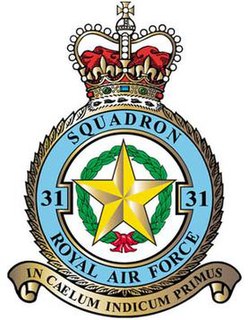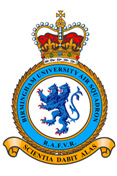
The Coupe d'Aviation Maritime Jacques Schneider, commonly called the Schneider Trophy or Schneider Prize, was a trophy awarded annually to the winner of a race for seaplanes and flying boats. The Schneider Trophy is now held at the Science Museum, South Kensington, London.

The MacRobertson Trophy Air Race took place in October 1934 as part of the Melbourne Centenary celebrations. The race was devised by the Lord Mayor of Melbourne, Sir Harold Gengoult Smith, and the prize money of £15,000 was provided by Sir Macpherson Robertson, a wealthy Australian confectionery manufacturer, on the conditions that the race be named after his MacRobertson confectionery company, and that it was organised to be as safe as possible.

Surya Kiran is an aerobatics demonstration team of the Indian Air Force. The Surya Kiran Aerobatic Team (SKAT) was formed in 1996 and are a part of the 52nd Squadron of the IAF. The team has since performed numerous demonstrations usually with nine aircraft. The squadron was composed of the HAL HJT-16 Kiran Mk.2 military trainer aircraft till 2011 and were based at the Bidar Air Force Station in Karnataka. The team was suspended in February 2011 and was re-established with Hawk Mk-132 aircraft in 2017.

Air racing is a highly specialised type of motorsport that involves airplanes or other types of aircraft that compete over a fixed course, with the winner either returning the shortest time, the one to complete it with the most points, or to come closest to a previously estimated time.

Number 31 Squadron, known as the 'Goldstars', was a squadron of the Royal Air Force. The Squadron lays claim to being the first military unit to fly in India, where it was based from 1915 to 1947. Throughout the Cold War, No. 31 Squadron was based in West Germany, flying from RAF Laarbruch and RAF Brüggen. Between September 1984 and March 2019, the Goldstars operated the Panavia Tornado GR1/4, initially from RAF Brüggen and after August 2001 from RAF Marham, Norfolk. No. 31 Squadron was disbanded on 14 March 2019 at RAF Marham and will reform sometime in 2024 at RAF Waddington operating the General Atomics Protector RG1.
No. 249 Squadron RAF was a Royal Air Force squadron, active in the sea-patrol, fighter and bomber roles during its existence. It was one of the top scoring fighter squadron of the RAF in World War II.

The Newmarket Racecourse is a British Thoroughbred horse racing venue in Newmarket, Suffolk, comprising two individual racecourses: the Rowley Mile and the July Course. Newmarket is often referred to as the headquarters of British horseracing and is home to the largest cluster of training yards in the country and many key horse racing organisations, including Tattersalls, the National Horseracing Museum and the National Stud. Newmarket hosts two of the country's five Classic Races - the 1,000 Guineas and 2,000 Guineas, and numerous other Group races. In total, it hosts 9 of British racing's 36 annual Group 1 races.

No. 603 Squadron is a squadron of the Royal Auxiliary Air Force, based in Edinburgh, Scotland. On reforming on 1 October 1999, the primary role of 603 Squadron, was as a Survive to Operate squadron, as well as providing Force Protection.

No. 310 Squadron RAF was a Czechoslovak-manned fighter squadron of the Royal Air Force in the Second World War.
The Tactical Police Squadron (TPS) is a group of around 150 regular and 50 reservist (RAuxAF) Royal Air Force Police with its headquarters at RAF Honington in Suffolk, England. The reservists comprise No 3 Police Squadron.
The No.3 Squadron (Cobras) of the Indian Air Force (IAF) operates as a Close Air Support (CAS) and reconnaissance unit. Currently based at Pathankot Air Force Station, No. 3 Sqn falls under the Western Air Command, and alongside the No. 26 Sqn (Warriors), No. 104HU and No.125HU (Gladiators), forms the 18 wing of the IAF.

The King's Cup Race is an annual British handicapped cross-country air race, is run by the Royal Aero Club Records Racing and Rally Association and was first contested on 8 September 1922. The event was open to Commonwealth pilots only.

Lympne Airport, was a military and later civil airfield, at Lympne, Kent, United Kingdom, which operated from 1916 to 1984. During the First World War RFC Lympne was originally an acceptance point for aircraft being delivered to, and returning from, France but was later designated as a First Class Landing Ground, RAF Lympne. It became a civil airfield in 1919 and saw the operation of early air mail services after the 1918 armistice. It was one of the first four airfields in the United Kingdom with customs facilities.

Number 601 Squadron is a squadron of the RAF Reserves, based in London. The squadron battle honours most notably include the Battle of Britain, and the first Americans to fly in the Second World War were members of this squadron. Reactivated in 2017, it is a specialist squadron "tapping into the talents of leaders from industry, academia and research to advise and shape and inspire [the RAF]".
The Festival Trophy is a Grade 3 National Hunt steeplechase in Great Britain which is open to horses aged five years or older. It is run on the Old Course at Cheltenham over a distance of about 3 miles and 1 furlong, and during its running there are twenty fences to be jumped. It is a handicap race, and it is scheduled to take place each year on the opening day of the Cheltenham Festival in March.

The University of Birmingham Air Squadron, commonly known as UBAS, is a squadron within the Royal Air Force established in 1942. It is based at RAF Cosford, Shropshire, and flies a fleet of six Grob Tutors. In 2009 the squadron upgraded the aircraft to the Grob Tutor EA which has an advanced avionics suite. The Squadron has four Flights, A, B, C and D; each with a student Flight Commander who holds the rank of Acting Pilot Officer and a Deputy who holds the rank of Officer Cadet. UBAS is also the parent squadron of 8 Air Experience Flight, who jointly fly UBAS' Tutor fleet.

No. 1459 (Fighter) Flight was formed at RAF Hunsdon, Hertfordshire on 20 September 1941, equipped with Turbinlite Douglas Boston and Douglas Havoc aircraft. By 21 September 1941 the flight moved to RAF Hibaldstow, Lincolnshire. On operations they cooperated with the Hawker Hurricanes of 253 Squadron.
The European Air Racing Championship is a handicapped air race arranged by the Royal Aero Club Records, Racing and Rally Association.
The world record loop is the record for the highest number of aircraft to successfully complete an aerobatic loop while flying in formation. The current record is 22 aircraft. The record was set by the Royal Air Force aerobatic team, the Black Arrows, who successfully looped 22 Hawker Hunter jet aircraft every day of the September 1958 Society of British Aerospace Companies Farnborough Airshow, beating the previous record set by the Pakistan Air Force, who looped the 16 North American F-86 Sabres in February 1958. The record required the team to train pilots from other RAF squadrons. The team initially wanted to loop 20 aircraft, but additional aircraft were added to the formation in order to improve the formations aesthetic appearance.
The Grosvenor Challenge Cup, commonly known as the Grosvenor Cup, was a trophy presented by Lord Edward Grosvenor in 1923 to the winner of a light aircraft time trial competition. Entries were initially restricted to British designs using aero engines of less than 150 horsepower. The first competitions were held at Lympne Aerodrome in Kent. The contest continued until 1935 with a break to 1949 when the Royal Aero Club resumed the races at Elmdon where the entry was opened to British and international designs with a weight less than 1,000 kilograms.












